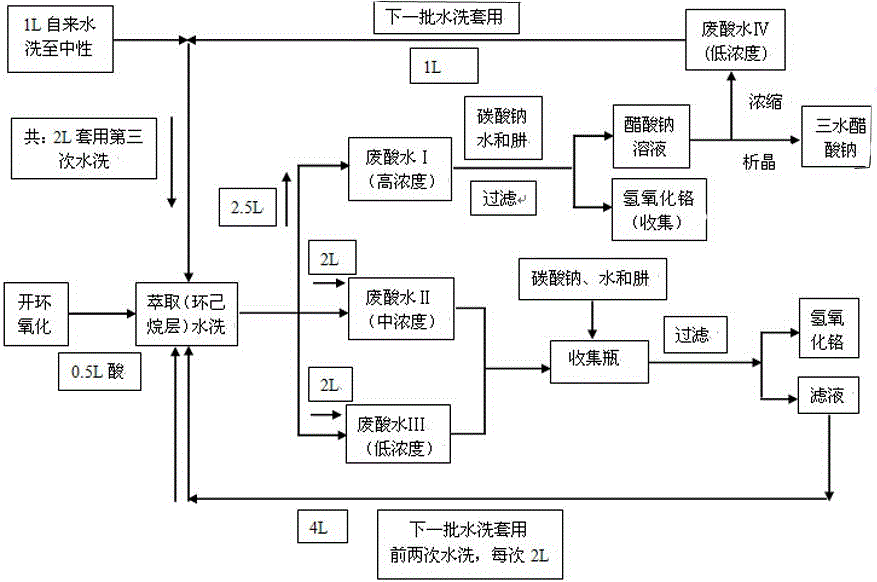A kind of method of dienolone acetate waste acid water recycling
A technology of dienolone acetate and diene waste acid water, which is applied in chemical instruments and methods, carboxylate preparation, chromium oxide/hydrate, etc., and can solve problems such as increased processing costs, waste of resources, and environmental pollution , to achieve the effect of simple method and convenient operation
- Summary
- Abstract
- Description
- Claims
- Application Information
AI Technical Summary
Problems solved by technology
Method used
Image
Examples
example 1
[0025] 1) Take 100g of saponin through ring opening, oxidative hydrolysis to synthesize dienolone acetate, after extraction with 2L of cyclohexane, wash the cyclohexane layer three times with 2L of drinking water until it is neutral, and collect three times respectively The separated acid water layer.
[0026] 2) Add 125g of sodium carbonate to the first high-concentration waste acid water to adjust the pH=8, add 2.5g of hydrazine hydrate, stir for 1h, filter to obtain Cr(OH)3, content: 98.1%; the filtrate is concentrated until it is concentrated When the filtrate is 2 / 5, the temperature is lowered to 10℃ to crystallize for 4h, and the sodium acetate trihydrate is obtained by filtration, content: 60%; the concentrated 1L wastewater and 1L fresh drinking water total 2L for the third production of the next batch Washed.
[0027] 3). Add 4g of sodium carbonate to the second and third waste acid water to adjust pH=8, add 1g of hydrazine hydrate, stir for 1h, filter to obtain Cr(OH)3, ...
example 2
[0029] 1) Take 100g of saponin through ring opening, oxidative hydrolysis to synthesize dienolone acetate, after extraction with 2L of cyclohexane, wash with the previous batch of waste acid water to neutral.
[0030] 2) Perform the first washing with the 2L filtrate of the second washing from the previous batch. After washing and stratification, high-concentration waste acid water is obtained. Add 200g of sodium carbonate to the high-concentration waste acid water to adjust pH=9, and add 3.75g Hydrazine hydrate, stirred for 1h, filtered to obtain Cr(OH)3, content: 98%. The filtrate was concentrated until 3 / 5 of the filtrate was concentrated, and the temperature was lowered to 15°C to crystallize for 6 hours, and sodium acetate trihydrate was obtained by filtration, content: 61%. A total of 2L of concentrated wastewater and 1L of fresh drinking water are used for the third washing of the next batch of production.
[0031] 3). Add 10g of sodium carbonate to the second and third was...
example 3
[0033] 1) Take 100g of saponin through ring opening, oxidative hydrolysis to synthesize dienolone acetate, after extraction with 2L of cyclohexane, wash with the previous batch of waste acid water to neutrality.
[0034] 2) Perform the first washing with the 2L filtrate of the second washing from the previous batch. After washing and stratification, high-concentration waste acid water is obtained. Add 125g sodium carbonate to the high-concentration waste acid water to adjust pH=8, and add 2.5g Hydrazine hydrate, stirred for 1h, filtered to obtain Cr(OH)3, content: 98.3%. The filtrate was concentrated until 2 / 5 of the filtrate was concentrated, and the temperature was lowered to 10°C for 4 hours to crystallize, and then filtered to obtain sodium acetate trihydrate, content: 60%. The concentrated wastewater is used for the third washing of the next batch of production.
[0035] 3). Add 4g of sodium carbonate to the second and third waste acid water to adjust pH=8, add 1g of hydrazin...
PUM
 Login to View More
Login to View More Abstract
Description
Claims
Application Information
 Login to View More
Login to View More - R&D
- Intellectual Property
- Life Sciences
- Materials
- Tech Scout
- Unparalleled Data Quality
- Higher Quality Content
- 60% Fewer Hallucinations
Browse by: Latest US Patents, China's latest patents, Technical Efficacy Thesaurus, Application Domain, Technology Topic, Popular Technical Reports.
© 2025 PatSnap. All rights reserved.Legal|Privacy policy|Modern Slavery Act Transparency Statement|Sitemap|About US| Contact US: help@patsnap.com

